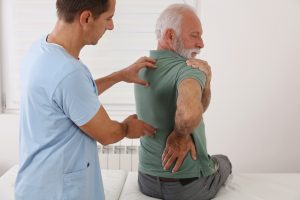
Spinal Stenosis and Walking Problems
Spinal stenosis can have a significant impact on your ability to move and perform daily activities. If you have this condition, you may struggle to walk long distances, lean forward for relief, or experience pain or numbness in your legs. These symptoms can greatly affect your quality of life, making it important to seek treatment.
Let’s explore the connection between spinal stenosis and walking difficulties, as well as what can be done to address the root cause of these symptoms.
What is Spinal Stenosis?
Spinal stenosis is a common condition that affects people as they age. It occurs when the spinal canal narrows, putting pressure on the spinal cord and nerves. This can cause a variety of symptoms, including pain, numbness, and weakness in the legs, arms, or back. Spinal stenosis most commonly occurs in the lower back (lumbar region) and neck (cervical region). If you suspect you have spinal stenosis, it’s important to see a doctor for a proper diagnosis. Your doctor may perform a physical exam, ask about your symptoms, and order imaging tests such as X-rays, CT scans, or MRIs to confirm the diagnosis.
The Connection Between Spinal Stenosis and Walking Problems
As the spinal canal narrows, it can put pressure on the spinal cord and nerves that travel through the lower back and legs. This can result in pain, numbness, and tingling in the legs, which can make it difficult to walk. As the condition progresses, walking may become more difficult and even painful, causing a limp or unsteadiness. In severe cases, spinal stenosis can cause difficulty standing, climbing stairs, or even walking short distances.
In addition to these conditions, spinal stenosis can also lead to a variety of other walking problems, such as:
- Difficulty lifting the feet
- Shuffling gait
- Decreased stride length
- Reduced walking speed
- Increased risk of falls
These walking problems can significantly impact a person’s quality of life, limiting their ability to perform daily activities and reducing their independence.
A Revolutionary Approach to Spinal Stenosis
If you’re suffering from spinal stenosis, your doctor or surgeon will likely present you treatment options for dealing with the damaged disc, but they won’t explain to you the natural disc-healing mechanism that delivers vital nutrients and water to your disc to help repair itself. When this mechanism stops working, it becomes the underlying problem that is causing the conditions you have now. By reestablishing your disc’s natural ability to repair itself, you’ll address the real problem, have less pain, and improve your quality of life.
At the Nerve & Disc Institute, we understand the connection between spinal stenosis and walking problems. We have developed a cutting-edge treatment program to help treat the underlying problem, not just the symptoms. Our exclusive treatment program, IntraDiscNutrosis, empowers your body’s natural healing process to address the root cause. Unlike traditional treatments such as drugs, therapies, epidurals, and pain lasers that merely provide temporary pain relief, IntraDiscNutrosis may reduce your discomfort while addressing the underlying issue to relieve pressure on the spinal cord and nerves, reducing pain, numbness, and tingling in the legs.
You Don’t Have to Live in Pain
If you’ve been hopping from doctor to doctor, consulting numerous specialists, and are seeking a solution that may provide long-lasting relief without resorting to surgery, injections, or pain medications, then you have come to the right place.
At the Nerve & Disc Institute, we have only one focus, which is to fix the disc problem safely without drugs or surgery. Our treatment program provides non-invasive solutions to relieve pressure on the spinal cord and nerves, which may reduce pain and improve mobility. If you are experiencing walking problems or other symptoms of spinal stenosis, contact the Nerve & Disc Institute today to learn more about our treatment program and how we can help.